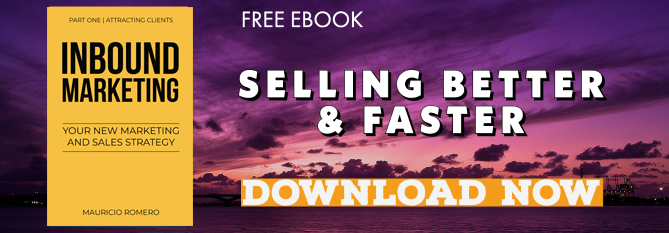
We had the chance to speak to Mauricio Romero, CEO of DataBranding, an expert company on Inbound Marketing. He told us about the change that he has witnessed has taken place from the tradicional marketing model to Inbound Marketing. Here are his words:
Who is Mauricio Romero?
"I'm DataBranding's CEO. I've always been in marketing and advertising. I studied Communication with a specialty in Marketing and then I started a Masters in Business Management. I started the company when I was 21 years old, that is, we started the company in 1997.
His First Company: Traditional Marketing
It was a company focused on working with advertising agencies and we only did TV commercials. We were in charge of the production and post-production of commercial film and video. Not so long ago, all the television commercials were made in movie formats and then they were turned into video, because it was the equipment that had the highest quality.
It really was very easy to do marketing because we had very little mass media, there were few channels (in Mexico). In the 90's, half of the population had public television and had no other choice. The penetration rate, for example, of cable TV was ... What was it? around a 30% (more-less); only 30% had access to 100 cable TV channels.
So it was very easy to do marketing because people had to watch the 3-4 channels that they had, which meant that they had no other choice but to watch those shows that someone else had programmed for them.
As advertisers, we had the problem of being limited in time and space in order to do something good. That's why the commercials were 20-30 seconds long and they were very expensive to produce.

TV commercial were a message that would reach 99% of the population in Mexico and which, when broadcasted enough (repeatedly) at a specific time (prime time), people would definitely watch it, there was no other option!
We would broadcast on 3 channels, at prime time, and 90% of the people in Mexico would watch our commercial. You could immediately see the impact that your TV commercial had on sales; sales went up at least a 30%.
So our commercials were very noticeable and it was very easy to advertise. You just needed a client who had a lot of money because it was very expensive. Producing a TV commercial was a million pesos and to broadcast it was... how much was it? around 400-800 thousand pesos each time you broadcasted a commercial. I'm talking to you about the 90s. For that reason, those 20-30 seconds has to be perfect and very well produced, made by specialists only. All the marketing expensive costs were justified.
What Happened Then?
Internet happened. It gave us the freedom of being able to say: "I'm not going to watch what you decide I'm watching rather, I'm going to look for what interests me" and "I'm no longer restricted to a schedule, I can see it at any time I want, on you-tube or any channel I want, and I will watch it without commercials"
Why did we change? we can now avoid SPAM. When we now receive a message from someone that we do not want, and that does not concern us, we call it spam ... Advertising had always been spam: You were watching a content that you were interested on, and they interrupted you with something that had nothing to do with the content that you were watching. It was an exchange -and still is in some media-: "Ok, I get this free content and I will watch your advertisement". It's like an agreement that we always had with the media.
But... I am no longer restricted. Not with the internet.
- Not in time. I can watch videos for as long or as short as I want. I make this decision.
- Not in space. I can watch them from my cell phone, wherever I am
Se we are now free of the time/space format. And of programmed TV. I now program what I want to watch.
This changed it all, it changed how we connect with the media. What we want now is to look and find the content that we are interested in, not just watch what someone else programmed for us.
This is where the key to Inbound Marketing is.
Tradicional Marketing, Passive Clients
Before internet, advertising was spam, and it was based on a "everyone who has two eyes, a nose and two ears, will know me" thinking.
I give clients the example of menstrual pads. Menstrual pads company spent a lot of money on me (Mauricio), on getting me knowing them, and I will never be their client! Won't even buy them for someone else! You know, they sometimes say: "well at least moms will buy the product for the child" (children's products) Well, I don't even buy my wife's pads, right? I do not even think about doing it, it's something ... Am I explaining myself? And boy did they spend lots of money on getting me know their brand! Now, it was a form of passive advertising, customers were passive "I do not need you, but don't forget that I exist".
And companies gained their customer's trust by means of repetition: they became familiar. That's why when one saw a brand one would say "I know this one, it has to be a good brand, right?" But we really evaluated the brands by this criterion of familiarity.
Cutting the chase, the two main things that happened were:
- Change in the media
- Change on how we assess brands
Nowadays, it is not enough for a brand to be familiar to us; we really want to know if it goes with our lifestyle, if it is really going to solve our problem.
Inbound Marketing: From Passive Clients to Active Clients
This is where the Inbound Marketing strategy perfectly fits, because now, when I have a problem, the first thing I do is grab the cell phone and ask Google (or any other search engine) how to solve it and get my answers right away. This is an active way of being a client: I am looking for a solution myself.
We have entered the next stage of advertising, and as a company, you not only want to be present in the passive state, but you actually want to be present and available when the customer is active to buy or to solve a problem. If your brand solves that problem, then it's a perfect match!
Change from Traditional Marketing to Inbound Marketing: The Company's Return on Investment (ROI)
We still to talk about this change, from the companies' point fo view: Why did we change to the new paradigm and not continue being successful in the old one?
It's simple: Clients could no longer test out their ROI.

For example, we launched a TV campaign, we did very well in sales and the client would still ask "Hey, Mauricio, was the campaign really successful? or is it that sales increased because we launched it in a pa-day and it was also father's day? My natural reaction was to say "well look, I'm not sure, if you want to, we run a market study and analyze this for your next campaign".
I would later turn up with two quotes, one for the cost of the next campaign and one for the cost of measuring the campaign. The cost of measuring the campaign was practically the same as the campaign itself. Understandably enough, customers told us "well look, it would be amazing to test it and see the actual numbers, but I'd rather spend that money on another campaign". I mean, they had to choose between:
- Investing on a campaign and its analysis
- Investing on two campaigns (for almost the same amount of money)
Well, it always came down to this decision and we could not just tell our clients "well, our idea or our campaign really worked and it generated results, believe us".
In addition, people began to disconnect from traditional media and this obviously lowered the ROI of projects yet, everyone was still charging the same money for the same job. So, instead of actually having the campaigns analyzed, the immediate reaction of our clients was: "I'll stop doing them".
The TV commercials' world started to crumble down and clients just did not know whether to continue or not, since they were not sure if it all generated a ROI to their companies.
So, what's the deal with Inbound Marketing? Inbound Marketing does offer the possibility to tell our clients: "Look, we generated an article, this article brought this many visitors, and these visitors asked for your product, and from all this dynamic, these many sales were generated."
We can tell our clients the actual cost/worth of an article. Companies can really prove the ROI of our campaigns.
This is thus, a very easy way for our customers to see that they do generate results with Inbound Marketing, while in traditional marketing ... it is still a matter of speculation or, if you want to measure things, the analysis ends up being just as expensive as doing the campaign itself! Nobody ends up measuring it, that's the reality! I mean, only very large companies do.
Benefits of Inbound Marketing
Tu sum things up:
- Knowing your ROI for sure
- Being THERE when clients are looking to find a solution, to buy something
These are the two main benefits of Inbound Marketing facing traditional marketing and they are the reason why this new digital marketing paradigm is actually working better with time.
Making a Connection with Brands
One last thing that changed is our connection with brands.
I had this advertising teacher who used to say: "When a brand does not have that "special something" to say about them, or you just really do not know what to say, sing it and, there! you'll have a jingle." It was very bold to say it like this but yes, it was the reality in the "old-days" advertising; You just made a jingle and it would make people stick to the product because they would go, "ok, I am familiar with this brand", it would have already generated trust on them.
That doesn't work anymore. These days, your could have been using an i-phone for years and if all of a sudden, Samsung creates a better product, you'd go "good-bye i-phone! I am no longer interested in you, you are of no use to me. Hey! weren't you loyal to the brand? No, you were not, you were loyal to the product that better solved your needs. We are never loyal to a brand, we are always loyal to whoever better solves our problem.
That is also another change of mentality that brands have to focus on today, and Inbound Marketing, with its strategy of better informing the customer with content about the products, solves this problem very well. "

With these words, our interview with Mauricio ended. We are grateful for the time he spent on this interview and for the information that he shared with us.
If you would like to know more about Inbound Marketing and this new digital marketing strategy, contact us. DataBranding is a company with the experience on Inbound Marketing that your business needs in order to exponentially grow.

 Paulina Romero H
Paulina Romero H
